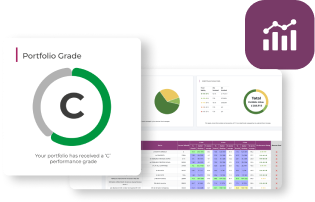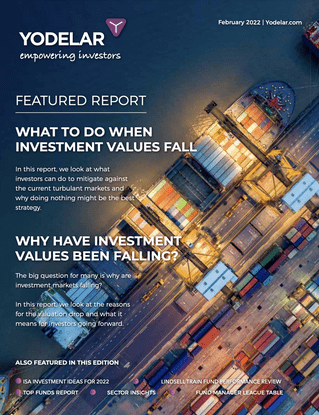- Out of 263 US equity funds analysed, only 37 achieved top 4- or 5-star ratings across the 6-month, 1-year, 3-year, and 5-year periods.
- 62% of U.S. equity funds have a history of underperformance, with 82 receiving a low 1-star rating and 81 rated just 2 stars.
- Over-reliance on U.S. equities can limit diversification and expose investors to increased regional and sector-specific risk.
- The Invesco EQQQ Nasdaq 100 ETF stands out as a consistent top performer in the IA North America sector, delivering an impressive 108.76% return over the past 5 years.
- The Lazard US Equity Concentrated C Acc GBP fund, by contrast, has consistently ranked among the poorest performers in the IA North America sector over the periods analysed.
U.S. equity funds continue to be the most popular growth-oriented investment choice among UK investors. Backed by a strong track record of long-term performance, the IA North America sector has become a core allocation in many portfolios. According to the Investment Association, it now accounts for nearly £106 billion - representing around 8% of the £1.27 trillion invested across the 56 IA sectors available to UK investors.
However, 2025 has brought renewed volatility to the sector. Although the U.S. economy showed resilience earlier in the year, investor sentiment was unsettled by renewed tariff disputes, interest rate uncertainty, and mixed corporate earnings. These factors triggered market turbulence and exposed a widening performance gap among funds. While some funds have continued to deliver strong returns, others have fallen behind their sector benchmarks.
In this article, we highlight 10 of the best-performing U.S. equity funds of 2025, based on their returns over the past 6 months, 1 year, 3 years, and 5 years. We also examine 10 of the lowest-performing funds over the same timeframes, offering a clear view of the performance gap that exists across the sector.
U.S. Equity Fund Performance Summary
We conducted a comprehensive review of 263 U.S. equity funds, assessing their performance and sector rankings over the past 6-month, 1-year, 3-year, and 5-year periods. Each fund was evaluated and assigned an overall performance rating based on its returns relative to peers within its sector.
Our findings reveal that only 37 of the 263 funds earned top performing 4 or 5 star ratings -reflecting their consistent ability to outperform sector peers across multiple timeframes.
In contrast, approximately 62% of funds underperformed. A total of 163 received a poor-performing 1 or 2-star rating by consistently delivering returns below the sector average.
This highlights the disparity in performance and overall quality between funds within these highly competitive sectors.

How Yodelar Rate Fund Performance
10 Top Performing U.S. Equity Funds
The 10 funds listed below have consistently ranked among the top U.S. equity funds of 2025 within the IA North America and IA North American Smaller Companies sectors. Their results over the most recent 6-month, 1-year, 3-year, and 5-year periods demonstrate a proven ability to deliver competitive returns in different market environments.
Each of these funds achieved a top 4 or 5-star rating, reflecting their consistent outperformance relative to sector peers.

The below table provides the discrete annual performance for each of the 10 funds over the past 5 full years.

1. Alger American Asset Growth Fund
Launched in December 2013, the Alger American Asset Growth Fund has established itself as one of the most consistent performers within the IA North America sector. The fund aims to achieve long-term capital growth by investing in US-listed equities with strong growth potential, including large-cap technology leaders and innovative mid-cap firms.
With £430.56 million in assets under management, the fund has demonstrated consistent strength across all major timeframes. Over the past 6 months, it returned -0.79%, which was comparatively strong during a challenging period for US equities, where the sector average fell by -8.29%.
Its recent 1 year return of 20.59% far exceeds the sector average of 5.15%, while its 3-year cumulative return of 79.46% is more than double the sector average of 31.26%. Over the recent 5 years, the fund has delivered 97.23% growth, placing it among the highest performers in the sector.
The fund’s results have been driven by a high-conviction growth strategy and significant exposure to some of the most dominant technology and consumer platform companies. Key holdings include Microsoft, NVIDIA, Amazon, Meta Platforms, and AppLovin - all of which have contributed strongly to the fund’s outperformance across multiple periods.
2. CT North American Equity 2 Fund
The CT North American Equity Fund 2 is designed to deliver long-term capital growth and income by investing primarily in North American equities. At least 80% of the fund’s portfolio is allocated to companies that are listed, headquartered, or generate a significant portion of their revenues in the US or Canada. It currently manages £301.10 million in assets.
The fund has produced strong performance across all key timeframes. Over the most recent 6 months, it returned -4.53%, a notable result relative to the sector average of -8.29%. Over 1 year, the fund delivered a gain of 10.91%, more than double the sector average of 5.15%.
Its 3-year return of 47.37% compares favourably with the sector average of 31.26%, and over 5 years it achieved 99.81% growth — well ahead of the sector’s 72.35% average.
This level of consistency reflects a disciplined and effective investment approach, underpinned by high-conviction positions in sectors such as technology, financials, and healthcare. The fund’s ability to capitalise on structural growth trends in these areas has played a key role in its long-term outperformance.
3. Fidelity Index US P Fund
The Fidelity Index US Fund P is a passively managed fund designed to deliver long-term capital growth by tracking the performance of the S&P 500 Net Total Return Index (NUK), which reflects a 15% withholding tax to match the fund’s tax treatment. While the fund aims to replicate index performance, it does so through optimised sampling rather than full replication — a method that helps reduce costs and improve operational efficiency.
With £7.18 billion in assets under management, it is among the largest funds in its sector. Its low ongoing charge of 0.06% and broad exposure to US large-cap stocks make it a popular choice for cost-conscious investors seeking diversified access to the US equity market.
Performance has been consistently strong across all periods. Over the most recent 6 months, the fund returned -5.65%, ahead of the sector average of -8.29%. Over 12 months, it gained 8.30%, outperforming the sector average of 5.15%. Across 3 years, it delivered cumulative growth of 42.78%, and over 5 years, 91.83% — both exceeding the sector averages of 31.26% and 72.35%, respectively.
Its performance reflects broad exposure to high-growth sectors such as technology and healthcare, which have been key contributors to long-term returns. The fund’s passive strategy, combined with its scale and efficiency, has positioned it well to capture structural growth across the US market while maintaining resilience in more volatile conditions.
4. HSBC American Index C Fund
With £15.25 billion in assets under management as of May 2025, the HSBC American Index C Fund is one of the largest and most widely held funds in the IA North America sector. The fund aims to achieve long-term capital growth by tracking the performance of the S&P 500 Index, investing directly in the shares of its constituents.
In addition to holding equities, the fund may retain cash for liquidity purposes and utilise HSBC-managed collective investment schemes to support daily cash flow management. This passive, rules-based approach provides efficient exposure to the largest and most influential companies listed in the United States.
The fund has delivered consistently strong returns over multiple timeframes. Over the past 6 months, it returned -6.09%, outperforming the sector average of -8.29%. Over 1 year, it returned 7.11% compared to the sector average of 5.15%, while its 3-year return of 42.23% and 5-year return of 91.38% both exceeded sector averages of 31.26% and 72.35%, respectively.
Its low cost has also played a significant role in enhancing returns. With an ongoing charge of just 0.06%, the fund provides a cost-efficient route for investors seeking diversified exposure to the US equity market through a passive, index-tracking approach.
5. Invesco EQQQ NASDAQ 100 UCITS ETF
The Invesco EQQQ NASDAQ 100 UCITS ETF is a widely held exchange-traded fund designed to track the performance of the NASDAQ 100 Index — a benchmark comprising 100 of the largest non-financial companies listed on the NASDAQ Stock Exchange. Its focus on high-growth, innovation-driven sectors such as technology, retail, and biotechnology has made it a go-to option for investors seeking concentrated exposure to US market leaders.
The fund uses full physical replication to mirror the holdings and weightings of the index, ensuring tight tracking and minimal deviation. To manage risk, it allows for a maximum allocation of 20% to any single issuer, rising to 35% under exceptional conditions — a necessary safeguard given the index's high concentration in a handful of dominant tech names.
With £10.31 billion in assets under management, this 5-star rated ETF has delivered consistently strong returns relative to its North America sector peers. Over the past 6 months, the fund returned -3.72%, significantly outperforming the sector average of -8.29%. Over 1 year, it returned 7.9%, also ahead of the sector average of 5.15%. Its 3-year cumulative return of 59.43% comfortably surpassed the sector average of 31.26%, while its 5-year return of 108.76% was among the highest in the sector — reflecting substantial long-term growth.
These returns are driven by concentrated exposure to some of the world’s most influential companies, including Apple, Microsoft, and NVIDIA. The fund’s focus on scalable, profitable firms operating in high-growth industries has made it one of the standout performers in the North American equity space.
6. iShares S&P 500 Industrials Sector UCITS ETF
The iShares S&P 500 Industrials Sector UCITS ETF seeks to track the performance of an index comprising U.S. industrial companies, as classified by the Global Industry Classification Standard (GICS). With £351 million in assets under management, it offers targeted exposure to industries such as aerospace, defence, transportation, engineering, and manufacturing.
It adopts a passive strategy using full physical replication, holding the index constituents in line with their weightings in the S&P 500 Capped 35/20 Industrials Index.
Over the past six months, the fund returned -5.81%, outperforming the sector average of -8.29%. Its longer-term performance has been particularly impressive, with returns of 12.38% over one year, 45.51% over three years, and 106.14% over five years—consistently ahead of North America sector averages.
The fund’s outperformance has been driven by rising infrastructure investment and a resurgence in capital projects across the U.S. Industrial companies have gained from strong demand for equipment, expanded logistics operations, and higher public and private construction spending.
Robust earnings from key holdings such as Honeywell, Union Pacific, Caterpillar, and Deere—alongside rising investment in automation and data infrastructure—have further boosted overall returns. With a low ongoing charge of just 0.15%, it offers a cost-effective option for growth-focused investors looking to gain exposure to the U.S. industrial sector.
7. Schroder QEP US Core Fund
The iShares S&P 500 Industrials Sector UCITS ETF offers targeted exposure to the US industrials sector, tracking an index of companies classified under the Global Industry Classification Standard (GICS). With £351 million in assets under management, the fund provides access to key industries including aerospace, defence, transportation, engineering, and manufacturing.
Using a passive strategy and full physical replication, the fund mirrors the S&P 500 Capped 35/20 Industrials Index — ensuring that individual positions remain diversified and capped to reduce concentration risk.
Over the past 6 months, the fund returned -5.81%, outperforming the North America sector average of -8.29%. Its 1-year return of 12.38% also exceeded the sector average of 5.15%, while its 3-year growth of 45.51% and 5-year return of 106.14% significantly outpaced sector averages of 31.26% and 72.35%, respectively.
This strong performance has been fuelled by a renewed wave of infrastructure investment and robust demand for capital goods across the US economy. Industrial leaders in the fund — including Honeywell, Union Pacific, Caterpillar, and Deere — have benefited from a combination of cyclical recovery, supply chain investment, and long-term shifts toward automation and data-driven logistics.
With a low ongoing charge of 0.15%, the fund offers a cost-efficient way for investors to gain focused exposure to a high-performing segment of the US equity market.
8. T. Rowe Price US Large Cap Growth Equity C Fund
Established on 29 May 2018, the T. Rowe Price US Large Cap Growth Equity C Fund aims to increase the value of its shares through capital growth. It is actively managed and primarily invests in large U.S. companies with above-average and sustainable earnings growth potential.
At least 70% of its assets are allocated to shares and related securities of companies either incorporated in the U.S. or conducting most of their business there. These companies have market capitalisations equal to or greater than those in the Russell 1000 Index. The portfolio typically holds between 60 and 75 stocks, targeting firms with competitive advantages and long-term growth drivers such as innovation and structural economic change.
This £137.72 million fund returned -4.12% over the past six months, outperforming the IA North America sector average of -8.29%. Over one year, it achieved a return of 12.02%, more than double the sector’s 5.15%. The three-year return was 71.44%, compared to 31.26% for the sector. Its five-year return reached 88.73%, placing it in the top 50% of its peer group.
The fund’s success and return potential in the U.S. equity space have been supported by several key factors. It focuses on companies with durable growth drivers, particularly those benefiting from innovation and long-term economic shifts. The portfolio is diversified across sectors, helping to manage risk. Active management provides flexibility beyond the benchmark, allowing the team to invest in high-conviction opportunities. Lastly, the fund is led by an experienced team backed by in-depth research. Together, these elements have helped boost performance over time.
9. UBS US Growth C Fund
The UBS US Growth C fund has distinguished itself as a top-performing U.S. equity fund, within the North America sector across multiple timeframes. In the first half of 2025, it returned -3.68%, outperforming the sector average. Over one year, it delivered a 10.28% gain—nearly double the sector’s return. Its three-year performance was even more impressive, with a 60.23% return in its sector. Over the past five years, the fund delivered growth of 90.14%, markedly ahead of the sector’s 72.35% average.
This actively managed fund currently oversees £497.25 million in client assets. Its primary objective is to grow investor capital and outperform the S&P 500 Index after charges over a medium to long-term horizon (typically 3 to 5 years). To achieve this, at least 80% of the fund is invested in large-cap U.S. equities.
A key factor behind the fund’s consistent outperformance is its strategic allocation to high-growth sectors, particularly technology. The portfolio features leading companies recognised for their lasting competitive edge and dependable earnings growth. Its investment approach centres on selecting businesses with long-term growth potential—a focus that has helped the fund achieve notable returns, even amid market fluctuations in 2025.
10. CT US Smaller Companies Fund
Managed by Columbia Threadneedle, the CT US Smaller Companies Fund is designed to achieve long-term capital growth with some income, over at least 5 years.
It primarily invests in smaller and mid-sized US companies with market capitalisations below US$10 billion, across all sectors. Eligible firms are those incorporated, domiciled, or conducting significant business in the United States.
The fund may also hold securities, investment funds, cash, and money market assets where appropriate.
Despite being the smallest fund in its category, managing £66.99 million, its performance has been consistently exceptional. Over the past six months, it posted a return of -16.10%, well above the sector average of -17.83%. Over one year, it delivered a 2.13% gain, compared to the sector’s -3.71%, ranking 2nd out of 31 funds in its category. Its three-year return of 24.30% also placed it 2nd in the sector, while its five-year performance reached 78.11%, far exceeding the sector average of 47.11%. These results make it one of the consistently best-performing funds in the IA North American smaller companies sector sector.
Its outperformance stems from a carefully constructed portfolio diversified across key sectors such as financials, healthcare, and industrials. Core holdings include income-generating companies such as Insmed Inc, Option Care Health Inc, Palomar Holdings Inc, Tanger Inc, Heritage Insurance Holdings Inc, and Metropolitan Bank Holding Corp, all of which have contributed meaningfully to its sustained returns.
Additionally, the fund uses derivatives for efficient portfolio management, helping reduce risk and control costs in a competitive market landscape.
Worst Performing U.S. Equity Funds
Not all U.S. equity funds have delivered consistent results. In fact, many have faced challenges and failed to keep pace with their sector averages. As our performance analysis shows, 163 funds have underperformed their peers and received a low 1 or 2-star rating.
From this group, the table below highlights 10 of the worst-performing U.S. equity funds, based on returns over the past 6 months, 1 year, 3 years, and 5 years. Each of these funds has been awarded a 1-star rating due to their consistently weak performance.

The below table provides the discrete annual performance for each of the 10 funds over the past 5 full years.

Over-Reliance on North America: A Growing Risk for UK Investors
North American equities have generated strong returns in recent years, fuelled primarily by the exceptional growth of large-cap technology firms. As a result, they have become a core allocation for many UK investors. However, this success has led to a growing imbalance in many portfolios, where exposure to the U.S. - particularly the tech sector - has become disproportionately high. Such concentration not only reduces true global diversification but also introduces structural risks that could undermine long-term portfolio resilience.
The US equity market has become increasingly dominated by a small number of mega-cap technology companies, including Apple, Microsoft, Amazon, and NVIDIA. Each of these firms is now valued at over $2.7 trillion and together they make up a significant share of the S&P 500. While their growth has driven much of the market’s recent performance, this concentration also raises risks for investors whose portfolios are heavily weighted toward the US.
If the technology sector were to slow - due to regulation, weaker earnings, or falling demand - those with high North American exposure could see sharp losses. This risk was evident in 2022, when a correction in overvalued tech stocks led to widespread declines across global portfolios.
Wider economic pressures also add to the concerns. By mid-2025, the US national debt had surpassed $36.2 trillion, with interest payments exceeding $1 trillion a year - more than the country spends on defence or Medicaid. This rising debt burden could keep interest rates higher for longer, which may squeeze corporate profits and slow economic growth.
The Importance of Diversification: Responding to Global Market Shifts
Markets move in cycles, with different regions and sectors coming into favour at different times. These shifts are driven by a range of factors—including economic conditions, geopolitical developments, and broader global trends. While government policies, including those from the White House, may influence short-term sentiment, long-term market leadership is never fixed. Technology has dominated recent years, but sectors such as energy, infrastructure, and healthcare have also led during different market phases.
History shows that markets adapt, even through periods of political or economic uncertainty. Innovation, industrial development, demographic change, and technological advancement continue to drive global growth across multiple regions. Opportunities arise not just in one sector or economy, but in many—often in areas that investors least expect.
This makes diversification essential. Spreading investments across geographies, industries, and asset classes reduces the impact of localised risks—be they political, economic, or sector-specific. It also provides balance: underperformance in one area can be offset by gains in another. A well-diversified portfolio is better positioned to weather volatility and capture growth opportunities as they emerge, helping investors build long-term resilience in a constantly evolving market environment.
Many Investors Are Taking on More Risk Than They Realise
At Yodelar, we analyse thousands of investment portfolios each year through our free portfolio review service. Our findings clearly show a significant rise in investors—both advised and non-advised - who are neglecting proper risk management. Instead of following a structured asset allocation strategy, many are chasing recent high-performing areas such as North American equities and tech-focused funds.
Despite the risks highlighted throughout this article, an increasing number of investors are abandoning diversified strategies in pursuit of short-term returns. A growing proportion are heavily weighting their portfolios towards North America-focused funds - drawn in by recent strong performance - while overlooking other sectors that, though less impressive in the short term, are essential for long-term portfolio balance.
Intentional or not, this over-concentration has become a widespread issue among UK investors. In many cases, it’s reinforced by advisers who rely heavily on multi-asset or global equity funds, which often have a strong North American bias. This creates a misleading sense of diversification, while leaving portfolios underexposed to other regions and asset classes.
Improve Outcomes with Expert Guidance from Yodelar
Diversifying across sectors, regions, and asset classes helps investors manage risk and remain resilient through unpredictable market shifts. Spreading investments beyond a single market not only balances risk but also improves the potential to capture growth in different areas, even during periods of market stress.
In an environment shaped by economic uncertainty and shifting policy professional advice is more valuable than ever. An experienced adviser can help build and maintain an efficient portfolio strategy that maintains longterm balanced while also optimising growth opportunities.
At Yodelar, we've conducted over 30,000 portfolio reviews and have seen first-hand how many investors chase recent top-performance without realising the risks this creates through duplication and poor diversification. Having an expert take control can often led to the best outcomes.

















